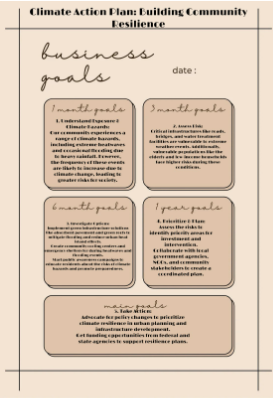Climate Action Plan: Building Community Resilience
1. Understand Exposure & Climate Hazards:
Our community experiences a range of climate hazards, including extreme heatwaves and occasional flooding due to heavy rainfall. However, the frequency of these events are likely to increase due to climate change, leading to greater risks for society.
2. Assess Risk:
Critical infrastructures like roads, bridges, and water treatment facilities are vulnerable to extreme weather events. Additionally, vulnerable populations like the elderly and low-income households face higher risks during these conditions.
3. Investigate Options:
Implement green infrastructure solutions like absorbent pavement and green roofs to mitigate flooding and reduce urban heat island effects.
Create community cooling centers and emergency shelters for during heatwaves and flooding events.
Start public awareness campaigns to educate residents about the risks of climate hazards and promote preparedness.
4. Prioritize & Plan:
Assess the risks to identify priority areas for investment and intervention.
Collaborate with local government agencies, NGOs, and community stakeholders to create a coordinated plan.
5. Take Action:
Advocate for policy changes to prioritize climate resilience in urban planning and infrastructure development.
Get funding opportunities from federal and state agencies to support resilience plans.
Contact us
Thank you for your interest in contacting Future Engineers. We look forward to connecting with you!
General Inquiries
support@futureengineers.orgSponsorship Inquiries
sponsor@futureengineers.org
